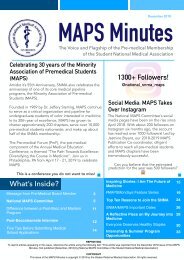JSNMA SUMMER 2019 Sneak Preview
You also want an ePaper? Increase the reach of your titles
YUMPU automatically turns print PDFs into web optimized ePapers that Google loves.
48 Commentary<br />
WHAT WE “DO”:<br />
UNDERSTANDING<br />
OSTEOPATHY<br />
SARAH K. GREWAL, OMS-II , YASMEEN R. DAHER, OMS-II<br />
A. T. STILL UNIVERSITY SCHOOL OF OSTEOPATHIC MEDICINE IN ARIZONA<br />
Since 1990, the number of osteopathic physicians<br />
(DOs) has increased by 250%. Despite this<br />
massive expansion of the DO profession, many<br />
are still not aware of the similarities and differences<br />
between what a DO and MD can offer.<br />
Founded in 1874, osteopathic medicine is an<br />
evidence-based practice that is compatible with and<br />
complementary to traditional allopathic medicine.<br />
The founder of osteopathy, Dr. Andrew Taylor Still,<br />
was an allopathic physician (MD) who envisioned<br />
a new kind of physician—one who practiced<br />
healing rather than the false or even harmful<br />
practices that many “doctors” of the 19th<br />
century employed. In particular, Dr. Still<br />
explored the musculoskeletal system and<br />
how it could be manipulated to promote the<br />
body’s overall wellbeing. This came to be<br />
known as osteopathy, a word that combines<br />
the Greek roots osteo, meaning bone,<br />
and pathos, which means suffering. 1 Dr.<br />
Still’s work lead to the 4 tenets of osteopathic<br />
medicine, the principles that all DO students learn<br />
to practice:<br />
1. The body is a unit; the person is a unit of<br />
body, mind, and spirit.<br />
2. The body is capable of self-regulation,<br />
self-healing, and health maintenance.<br />
3. Structure and function are reciprocally interrelated.<br />
4. Rational treatment is based upon an<br />
understanding of the basic principles of body<br />
unity, self-regulation, and the interrelationship<br />
of structure and function. 2<br />
These tenets encompass the underlying values of<br />
osteopathic medicine. Perhaps the most defining<br />
characteristic of osteopathic medicine is relayed in<br />
the first tenet—the principle of unity. Instead of solely<br />
reducing the body down to its constituents, osteopathy<br />
values the fact that the body is integrated in all respects.<br />
Viewing the body as a unit of body, mind, and spirit<br />
allows osteopathic physicians to better treat and even<br />
prevent disease. For example, an obstruction could be<br />
treated or prevented with a lymphatic pump technique<br />
which enhances the flow of lymph throughout the body<br />
allowing for enhanced circulation and venous drainage.<br />
The last three tenets stem from the first tenet of unity,<br />
thus creating a foundation for osteopathic physicians<br />
that is rooted in holistic care. 3,4<br />
In 2018, there were over 28,000 students enrolled in<br />
osteopathic medical schools, making up over 25%<br />
of medical students in the United States.5<br />
The path of obtaining a DO degree shares<br />
many similarities to the MD curriculum.<br />
Both MD and DO students take a similar<br />
path that includes obtaining a bachelor's<br />
degree, taking the MCAT, and being<br />
accepted through a competitive admissions<br />
process. In medical school, both the DO and<br />
MD curriculums contain the same core of<br />
basic science, anatomy, pharmacology,<br />
etc. After medical school, osteopathic<br />
students obtain residencies and practice in<br />
every specialty of medicine alongside their<br />
allopathic counterparts. Uniquely, 56% of<br />
osteopathic physicians choose to pursue primary<br />
care specialties like family medicine, pediatrics,<br />
and internal medicine. 5,6 This is not surprising<br />
considering the four tenets and underlying<br />
values of osteopathic medicine. Furthermore,<br />
osteopathic physicians are thereby helping to<br />
fill the gaps of the increasing medical shortage<br />
in rural and underserved areas. 7<br />
The largest difference is that osteopathic students<br />
complete an additional 200 plus hours studying<br />
osteopathic manipulative medicine (OMM) during<br />
medical school. 8 OMM is a hands-on approach to<br />
diagnosis, treatment, and prevention. Students learn<br />
to use the musculoskeletal system to effect change<br />
throughout the body. This relies on the tenets of<br />
osteopathic medicine, most specifically that structure<br />
(anatomy) and function (physiology) are intrinsically<br />
related. Osteopathic physicians use OMM in addition<br />
to medication, surgery, etc. It is a tool that osteopathic<br />
J o u r n a l o f t h e S t u d e n t N a t i o n a l M e d i c a l A s s o c i a t i o n






